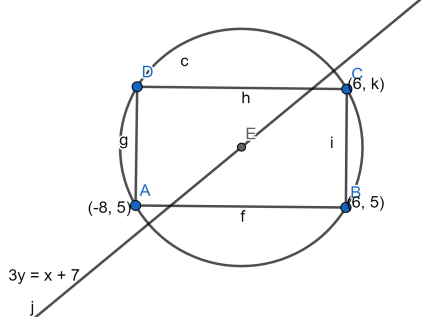
A rectangle is inscribed in a circle with a diameter lying along the line 3y = x + 7. If the two adjacent vertices of the rectangle are (-8, 5) and (6, 5), then the area of the rectangle (in sq. units) is
(a)72
(b)84
(c)98
(d)56
Answer
594.6k+ views
Hint: For solving such a question, we will assume a 3rd vertex as (6, k), this point must lie on the circle. Then, we will find out the center of the circle as it is midpoint of 1st and 3rd vertex by using midpoint formula that is given below:
\[P\left( x,y \right)=\left( \dfrac{{{x}_{1}}+{{x}_{2}}}{2},\dfrac{{{y}_{1}}+{{y}_{2}}}{2} \right)...........\left( 1 \right)\]
Complete step-by-step answer:
From the condition given in the question center must lie on the given line as the diameter is lying on this line. So we will get the value of k.
Then, we will find out the two adjacent side of rectangle by using distance formula is given below:
$AB=\sqrt{{{\left( {{x}_{1}}-{{x}_{2}} \right)}^{2}}+{{\left( {{y}_{1}}-{{y}_{2}} \right)}^{2}}}...........\left( 2 \right)$
Then, we will get area of rectangle by using the formula:
$A=\left( l\times b \right)........\left( 3 \right)$

Let us assume the third vertex of the rectangle as C(6, k).
Now we will find the midpoint of vertex A and C or we can say center of circle by using the midpoint formula given in equation 1. We have:
\[E\left( x,y \right)=\left( \dfrac{6-8}{2},\dfrac{k+5}{2} \right)=\left( -1,\dfrac{k+5}{2} \right)\]
Now, on putting this point on given line 3y = x + 7, we get:
$3\left( \dfrac{k+5}{2} \right)=-1+7$
On solving the above equation, we have:
$\begin{align}
& k+5=4 \\
& k=-1 \\
\end{align}$
Therefore, the third vertex of the rectangle is C(6, -1).
Now, we will get the distance of side AB and BC by using distance formula given in equation (2), we have:
$AB=\sqrt{{{\left( 6-\left( -8 \right) \right)}^{2}}+{{\left( 5-5 \right)}^{2}}}$
$\begin{align}
& =\sqrt{{{\left( 6+8 \right)}^{2}}+{{0}^{2}}} \\
& =\sqrt{{{\left( 14 \right)}^{2}}} \\
& =14 \\
\end{align}$
$\begin{align}
& BC=\sqrt{{{\left( 6-6 \right)}^{2}}+{{\left( -1-5 \right)}^{2}}} \\
& \,\,\,\,\,\,\,\,=\sqrt{{{0}^{2}}+{{\left( 6 \right)}^{2}}} \\
& \,\,\,\,\,\,\,\,=\sqrt{{{6}^{2}}} \\
& \,\,\,\,\,\,\,\,=6 \\
\end{align}$
Therefore, we will get the area of the rectangle by using the formula given in equation (3).
$\begin{align}
& A=14\times 6 \\
& \,\,\,\,\,=84 \\
\end{align}$`
Hence, the area of the rectangle is 84.
Note: As we know that this question is from coordinate geometry , questions from coordinate geometry can be solved in many ways. We have to look for the easiest and smallest path to solve such problems. We can also solve this problem by assuming 4th vertex as (-8, 5) then follow the same procedure to get the answer.
\[P\left( x,y \right)=\left( \dfrac{{{x}_{1}}+{{x}_{2}}}{2},\dfrac{{{y}_{1}}+{{y}_{2}}}{2} \right)...........\left( 1 \right)\]
Complete step-by-step answer:
From the condition given in the question center must lie on the given line as the diameter is lying on this line. So we will get the value of k.
Then, we will find out the two adjacent side of rectangle by using distance formula is given below:
$AB=\sqrt{{{\left( {{x}_{1}}-{{x}_{2}} \right)}^{2}}+{{\left( {{y}_{1}}-{{y}_{2}} \right)}^{2}}}...........\left( 2 \right)$
Then, we will get area of rectangle by using the formula:
$A=\left( l\times b \right)........\left( 3 \right)$

Let us assume the third vertex of the rectangle as C(6, k).
Now we will find the midpoint of vertex A and C or we can say center of circle by using the midpoint formula given in equation 1. We have:
\[E\left( x,y \right)=\left( \dfrac{6-8}{2},\dfrac{k+5}{2} \right)=\left( -1,\dfrac{k+5}{2} \right)\]
Now, on putting this point on given line 3y = x + 7, we get:
$3\left( \dfrac{k+5}{2} \right)=-1+7$
On solving the above equation, we have:
$\begin{align}
& k+5=4 \\
& k=-1 \\
\end{align}$
Therefore, the third vertex of the rectangle is C(6, -1).
Now, we will get the distance of side AB and BC by using distance formula given in equation (2), we have:
$AB=\sqrt{{{\left( 6-\left( -8 \right) \right)}^{2}}+{{\left( 5-5 \right)}^{2}}}$
$\begin{align}
& =\sqrt{{{\left( 6+8 \right)}^{2}}+{{0}^{2}}} \\
& =\sqrt{{{\left( 14 \right)}^{2}}} \\
& =14 \\
\end{align}$
$\begin{align}
& BC=\sqrt{{{\left( 6-6 \right)}^{2}}+{{\left( -1-5 \right)}^{2}}} \\
& \,\,\,\,\,\,\,\,=\sqrt{{{0}^{2}}+{{\left( 6 \right)}^{2}}} \\
& \,\,\,\,\,\,\,\,=\sqrt{{{6}^{2}}} \\
& \,\,\,\,\,\,\,\,=6 \\
\end{align}$
Therefore, we will get the area of the rectangle by using the formula given in equation (3).
$\begin{align}
& A=14\times 6 \\
& \,\,\,\,\,=84 \\
\end{align}$`
Hence, the area of the rectangle is 84.
Note: As we know that this question is from coordinate geometry , questions from coordinate geometry can be solved in many ways. We have to look for the easiest and smallest path to solve such problems. We can also solve this problem by assuming 4th vertex as (-8, 5) then follow the same procedure to get the answer.
Recently Updated Pages
Master Class 12 Economics: Engaging Questions & Answers for Success

Master Class 12 Maths: Engaging Questions & Answers for Success

Master Class 12 Biology: Engaging Questions & Answers for Success

Master Class 12 Physics: Engaging Questions & Answers for Success

Master Class 8 Maths: Engaging Questions & Answers for Success

Class 8 Question and Answer - Your Ultimate Solutions Guide

Trending doubts
What is meant by exothermic and endothermic reactions class 11 chemistry CBSE

10 examples of friction in our daily life

One Metric ton is equal to kg A 10000 B 1000 C 100 class 11 physics CBSE

1 Quintal is equal to a 110 kg b 10 kg c 100kg d 1000 class 11 physics CBSE

Difference Between Prokaryotic Cells and Eukaryotic Cells

What are Quantum numbers Explain the quantum number class 11 chemistry CBSE




